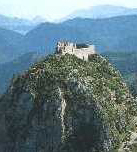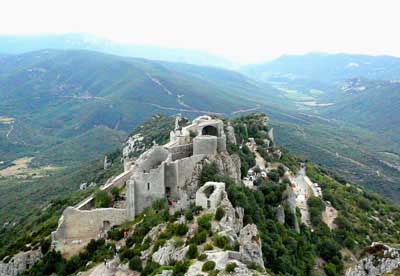For many centuries the Languedoc has witnessed repeated invasions, bloodshed and massacre. It was for this reason that early settlers had built hill top fortresses called oppida (one oppidum, more than one oppida).
Even when no wars were raging, bands of armed brigands would terrorise the population. In the middle ages such brigands, called "routiers", roamed the area. The rulers of the area, the Counts of Toulouse and had little hope of eliminating this menace. They retained their position as independent rulers by playing off against each other the Kings of Aragon, France and England.
|
As ancient peoples had built oppida, so the locals now built bastides, fortified hilltop villages, some of them "Circulades". Local nobles did the best they could, and built not merely hill-top castles but mountain-top castles. These medieval castles were wonderful defensive positions, often described as unassailable or "inexpungible". They came in handy for the next major war against the local population, or rather series of wars, which is generally known as the "Albigensian Crusade" or "Cathar Crusade". |
|

![]() The
local nobles could have simply handed over known Cathars
to the Crusaders to be burned alive, but they chose not
to. Bound to the land and their people, speaking
Occitan,
imbued with the ideals of the troubadours,
champions of toleration, and often Cathar believers themselves,
the nobles naturally helped and defended their Cathar families,
friends, allies and vassals. Castles throughout
the area became Cathar strongholds only in this sense.
With the exception of
Montségur these strongholds were never "Cathar
Castles", as tourist literature would have you believe.
The
local nobles could have simply handed over known Cathars
to the Crusaders to be burned alive, but they chose not
to. Bound to the land and their people, speaking
Occitan,
imbued with the ideals of the troubadours,
champions of toleration, and often Cathar believers themselves,
the nobles naturally helped and defended their Cathar families,
friends, allies and vassals. Castles throughout
the area became Cathar strongholds only in this sense.
With the exception of
Montségur these strongholds were never "Cathar
Castles", as tourist literature would have you believe.
After the Cathar Crusades, the position was little better. Even after the the area had been annexed to France at the end of the Crusades, the local population occasionally petitioned the King of Aragon to come to their rescue. The Black Prince terrorised the area in the fourteenth century. The French and Aragonese fought over it for centuries to come, and it was ravaged again at the end of the sixteenth century when Catholic France tried to exterminate another belief system that it regarded as a "heresy" - this time Protestantism.

![]() With
this continual instability it made sense for the French
kings to consolidate their hold on the area.
And they did this by demolishing the old mountain top fortresses
and building their own brand-new up-to-date state-of-the-art
castles on the same sites. Especially important
were the "Five Sons of Carcassonne",
five castles strategically placed to defend the new French
border against Aragon (the castles of Aguila,
Peyrepertuse,
Queribus,
Puilaurens
and Termes).
With
this continual instability it made sense for the French
kings to consolidate their hold on the area.
And they did this by demolishing the old mountain top fortresses
and building their own brand-new up-to-date state-of-the-art
castles on the same sites. Especially important
were the "Five Sons of Carcassonne",
five castles strategically placed to defend the new French
border against Aragon (the castles of Aguila,
Peyrepertuse,
Queribus,
Puilaurens
and Termes).
The need to keep up these these border fortresses disappeared after the present French-Spanish border was established by the Treaty of the Pyrenees in 1659. This new border - the present one - was further south than the old border, which corresponded to the modern border between the departements f the Aude and the PO). As a result of the treaty the old border defenses, Carcassonne and the "five sons of Carcassone" were slighted or left to decay, and then abandoned to the elements. For the most part it is these later constructions, deliberately destroyed by their owners, that the tourist literature advertise as "Cathar Castles".
The flip side of this - all but ignored by the tourist industry - is that, after 1659, Louis XVI commissioned a military genius, de Vauban, to build (or repair) another set of castles to protect the new border with Spain.
If you are interested in details of the castles known as
"Cathar Castles" (or in genuine Cathar centres) click here
![]()
If you are interested in the seventeenth century masterpieces,
some still in use today, click here
![]() .
.







